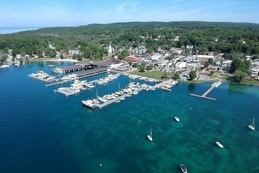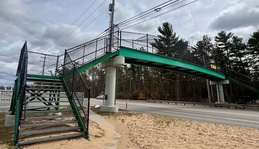The $50 Million Electrocution Case
Is TC going to be on the hook for more than it can afford?
Nov. 18, 2012

Michael Knudsen and his friends had no reason to believe that death was waiting for them when they jumped into West Grand Traverse Bay inside a marina breakwall in August, 2011.
A $50 million lawsuit filed on behalf of Knudsen’s estate describes the teenager’s harrowing last few moments alive:
"When Michael Knudsen jumped into the water at the end of F-Dock, he immediately began to struggle due to electric shock, and immediately attempted to swim and hold onto the F-Dock platform, at which time he was electrocuted," according to the suit, filed against the city of Traverse City, among other defendants, by high-profile downstate attorneys Geoffery Fieger and Jeffrey Danzig.
Knudsen’s friends looked on as the 18-year-old bled from his eyes, ears and nose and he struggled in the water, according to the suit. They attempted to lift him out of the water but when they grabbed his arms, they received an electrical shock.
A friend who was swimming with Knudsen and survived, Zachary Kott-Millard, also suffered electrical shock and has also filed a lawsuit.
"Michael’s friends helplessly watched as he drowned before their eyes, as Michael’s friends screamed for help, yelling for someone to turn off the electricity," the lawyers wrote.
SHARKS IN THE WATER 
Now lawyers are circling the Duncan L. Clinch Marina electrocution case like sharks in the water, seeking to assign blame for an electrical malfunction that caused Knudsen’s death.
The suit has dragged on for over a year now, and as an April, 2013 trial date approaches, the case has taken some twists and turns.
Among them: apparently Traverse City officials wanted to settle the case this summer, a move one city official says was blocked by the city’s insurance company.
Also: the city, which could be on the hook for a multi-million dollar judgment if it is found responsible, has filed crossclaims in the suit, seeking to turn the tables on co-defendants who helped design and construct a marina renovation a decade ago, a project which appears now to be the source of the problem that caused water in the marina to become electrified on Aug. 15, 2011.
TROUBLE FOR THE CITY
The cross-claims in the lawsuit filed by lawyers for Traverse City mean the defendants are now arguing among themselves over who is to blame, leaving the plaintiffs more or less to sit on the sidelines. Are those cross-claims a sign of desperation?
Danzig, the attorney overseeing the plaintiff’s case, said he had no comment.
TC attorney Enrico Schaefer, who has blogged about the case at his firm’s website, traverselegal.com, said the cross-claims aren’t necessarily signals the case is going badly for Traverse City.
Schaefer, who is not involved in the case, said it could be a matter of the city attempting to make sure they’ve identified everyone who might have some responsibility.
"It makes sense for them to bring everyone to the party," Schaefer said.
In the court file, there are two competing theories about what caused the malfunctions that caused Knudsen’s death -- some analysis points to the marina renovation design and construction, while elsewhere it is alleged that lack of maintenance since the renovation is to blame.
If it is defective design or construction, Traverse City and Clinch should be relatively well off when it comes time to divvy up percentages of liability, Schaefer said. If, on the other hand, it is found that the problem stemmed from a failure of marina staff to conduct maintenance, that could put more responsibility on the city.
"˜BANKRUPT UNTIL THE END OF TIME’
And that responsibility could be serious. When Fieger and Danzig filed the suit in September, 2011, they claimed damages of $50 million.
Juries can be unpredictable when it comes time to add up what is owed to right a wrong, Schaefer said.
"The jury’s got a lot of leeway when it comes to what kind of number they put on it," he said. "If it got to be a hundred million-dollar verdict, then Fieger could start collecting city assets."
City manager Ben Bifoss said the city’s insurance coverage is capped at $5 million. He said he could not comment on how the lawsuit is going and he referred questions to the city’s attorney, Gretchen Olsen, who did not return a message seeking comment.
City commissioner Jim Carruthers agreed that the stakes are huge for Traverse City.
Carruthers said commissioners authorized the city attorneys this summer to settle the suit within the city’s liability cap, but the city’s insurance company balked.
He said if the case was to go to trial and the plaintiffs got the $50 million they claimed at the outset, the result could be devastating.
"It would bankrupt Traverse City until the end of time," Carruthers said.
LOTS OF DEFENDANTS
There have been as many as 14 defendants named in the lawsuit, however, and it remains to be seen whether or how the burden would be spread among them, if that’s what the case comes to.
There are so many defendants because a lot of companies worked on the marina renovation, which saw construction commence in 2002. The grand opening of the new marina took place on Aug. 7, 2003.
SmithGroup JJR LLC won the contract to design the marina and Rhoades Engineering Corp. was selected to design the electrical system.
Both are now among the defendants and both have denied liability in court filings, arguing that the design of the marina was sound and their responsibility ended there.
Plans originally called for five floating docks to extend north into the water within the eastern breakwall. Later, a sixth floating dock was added, to be called F-Dock, to provide refuge for larger boats.
Since each boat slip needed to have an electrical hook-up, the design called for electrical wires to be run through PVC pipe under each dock to junction boxes, where wires would branch off to connect to shore power stations.
How those electrical hook-ups were designed, how they were installed, and how they were maintained is the crux of the lawsuit.
BOXES WERE METAL INSTEAD OF FIBERGLASS
The problem, according to a post-accident investigation, started in one of the junction boxes, where some wires frayed over time. Exposed copper wire came into contact with a metal junction box, electrifying the box. A circuit breaker failed to respond. That meant electricity spread from the junction box into other metal components in the floating dock and into the water, electrifying an area around the dock.
Rhoades, the designer of the electric system, argues that their plans called for the installation of fiberglass junction boxes instead of metal junction boxes, so that the boxes would not pose a danger by conducting electricity. In court filings, their attorney, Kent Gerberding, has argued the Rhoades’ electrical designs were not at fault.
SmithGroup’s and Rhoades’ lawyers argue that later, after the companies were out of the picture, changes were made. Those changes included the installation of metal boxes rather than fiberglass boxes.
SmithGroup and Rhoades also argue that their contracts ended before the completion of F-Dock, relieving them of responsibility.
Knudsen’s lawyers -- and now also Traverse City’s lawyers -- argue that Rhoades’ and SmithGroup’s responsibility was to see the project through to its completion to and make sure their designs were carried out.
MAINTENANCE FAILURE ALLEGED
Perhaps the most serious allegation against the city is that marina staff failed to properly maintain F-Dock.
F-Dock was supposed to have been taken out of the water for maintenance each winter, according to a motion filed by Kevin Gleeson, an attorney for SmithGroup.
The company that constructed the docks "clearly understood the dockage was to be disconnected and conveyed this to the City," Gleeson wrote. "The piers were not disconnected and stored as part of the winterization process. SmithGroup JJR cannot be held liable for the resulting damage."
Also, SmithGroup argues, the owner’s manual called for annual inspections of the electrical system which they say were not performed according to instructions.
The lawyers argue that years of wave motion on F-Dock and lack of maintenance is to blame for the electrical failure.
Lawyers for Traverse City and Clinch have denied the allegations.
CLINCH PARK MARINA SWIMMING
Another question raised by the lawsuit is this: how common was swimming in the marina, anyway, and did city officials look the other way?
Less than a month before Knudsen’s death, hundreds of locals got together to film what was called Traverse City LipDub 2011, a video that would go on to become a popular online celebration of Traverse City.
In the video, three men in swim suits jump from a railing at the south end of the marina. They appear to jump into marina water.
In the lawsuit, the plaintiffs argue that a "promotional video" for Traverse City proves how common swimming at the marina had been.
Fieger and Danzig also contend there were no "NO SWIMMING" signs posted around the marina at the time, an allegation that Clinch and the city deny.
In a court filing, Traverse City attorneys argue that swimming was not allowed in the marina.
"While it is admitted the City Defendants were aware people would sometimes swim or kayak in the marina, such activities were not authorized and, upon discovery, (those swimming or kayaking) were immediately asked to stop," the attorneys wrote.
Trending

A Year-Round Pizza Joint in Elberta
When we talk about fresh, house-made, and hand-crafted at a pizzeria, that means fresh dough daily, in-house sauces, hand-gr… Read More >>
Taste of Harbor Springs Celebrates 30 Years
Experience the many flavors of the local culinary scene at the 30th annual Taste of Harbor Springs, Saturday, Sept. 20, from… Read More >>
Fall-O-Ween in Gaylord
If you’re already starting to get the Halloween itch—decorations up, costume ready, bags of candy half-consumed&… Read More >>


